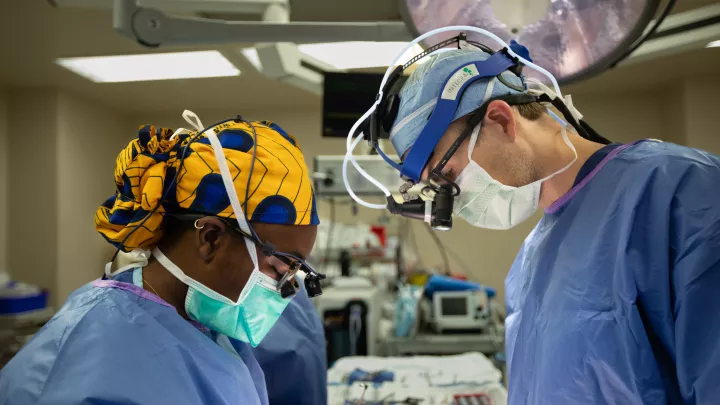Interventional Catheterization Program
Our experienced interventional cardiologists offer all types of cardiac catheterization procedures. We have two catheterization suites with advanced technologies that help us provide safe and effective care.
What Is Cardiac Catheterization?
Cardiac, or heart, catheterization uses a thin tube called a catheter to access your child’s heart. The doctor threads the catheter into an artery and guides it up to the heart. This procedure allows the doctor to see your child’s heart structure and measure heart function.
Doctors who specialize in heart catheterization procedures are called interventional cardiologists. Learn more about heart catheterization.
Interventional Catheterization Program: Why Choose Us
At Children's Hospital Los Angeles, your child receives care from leading pediatric interventional cardiologists. Our Interventional Catheterization Program also offers:
- Outstanding outcomes: We have one of the best safety records in the country for cardiac catheterizations. Catheterization involves some radiation, but we designed our lab to reduce your child’s exposure.
- Personalized, child-focused care: During your pre-procedure appointment, we explain what to expect from the moment you arrive at the hospital until discharge. Our specialized cardiac anesthesia team keeps your child safe and comfortable throughout the catheterization.
- Collaborative care team: Our interventional cardiologists work closely with the Heart Institute’s other cardiologists, electrophysiologists, heart surgeons and critical care experts. If your child needs more than one procedure, these specialists work together to perform them at the same time. This also includes non-cardiac treatments such as bronchoscopy, endoscopy, and ENT (ear, nose, throat or otolaryngology) procedures. Our goal is the best possible outcome with the fewest procedures.
- Advanced technology: Our Interventional Catheterization Program has ultra-low radiation capabilities, rotational imaging and the ability to create 3-D images of the heart and vessels. We can perform hybrid procedures that involve catheterization and surgery in either the catheterization laboratory or the operating room.
Why Does My Child Need Cardiac Catheterization?
Cardiac catheterization may be necessary to:
Diagnose a heart condition
Catheterization lets the doctor see inside your child’s heart. It provides more detailed pictures than regular imaging tests, such as chest X-rays. Doctors only use cardiac catheterization for diagnosis when less invasive tests don’t show enough detail.
Catheterization can also measure things in different parts of the heart. Doctors may measure:
- Blood flow
- Blood pressure
- Electrical activity
All this information improves diagnoses and helps doctors create detailed treatment plans.
Perform electrophysiology procedures
Doctors use catheterization to diagnose and treat heart rhythm problems (arrhythmias). This process is called an electrophysiology study (EP study). During EP studies, the doctor looks at your child’s heart to find the source of the abnormal heart rhythm.
Ablation is a catheterization procedure that uses heat or cold to repair the heart tissue causing the arrhythmia. Other arrhythmias can be treated with placement of a pacemaker or implantable cardioverter defibrillator (ICD) to regulate your child’s heart rhythm. Catheterization is a minimally invasive way to insert these devices.
Find out more about the Electrophysiology Program at Children's Hospital Los Angeles.
Deliver interventional cardiology treatments
Interventional cardiology involves using catheterization as a minimally invasive alternative to surgery. Treatments include:
- Balloon angioplasty: Doctors thread a catheter with a deflated balloon into the narrowed blood vessel. They inflate the balloon to stretch the narrowing. Sometimes, they insert a stent (hollow tube) to help keep the vessel open.
- Balloon valvuloplasty: Doctors thread a catheter with a deflated balloon into the narrowed valve. They inflate the balloon to stretch the valve.
- Catheter-based valve replacement: Doctors use a catheter to insert a replacement valve inside the existing valve.
- Closing holes in the heart: Doctors use a catheter to place mesh device or plug to close the hole.
- Stent placement: Doctors use a catheter to place a stent to hold a blood vessel open.
Monitor heart failure and heart transplant patients
Children with heart failure and those who get a heart transplant need regular monitoring. Catheterization lets doctors get a close look at your child’s heart function.
Types of Cardiac Catheterization Procedures
Heart catheterization procedures we perform include:
- Ablation to treat heart rhythm problems
- Electrophysiology study
- Pacemaker or ICD placement
- Balloon angioplasty to open narrowed or blocked blood vessels
- Balloon valvuloplasty to open blocked or narrowed valves
- Closure of atrial septal defects (ASD), patent ductus arteriosus (PDA) and ventricular septal defects (VSD)
- Stent placement for coarctation, pulmonary artery stenosis, and other narrowed vessels
- Transcatheter pulmonary valve placement
- Fontan surveillance procedures
Recognized expertise treating PDA in preemies
Our interventional cardiologists have built a reputation for successfully treating patent ductus arteriosus (PDA) in premature infants. Parents from across the country bring their babies to us for treatment.
The ductus arteriosus is a hole between the heart and lungs that usually closes within a few days of birth. If it doesn’t close, your baby may not get enough oxygen. By using catheterization, we prevent preemies with PDA from needing invasive surgery.


